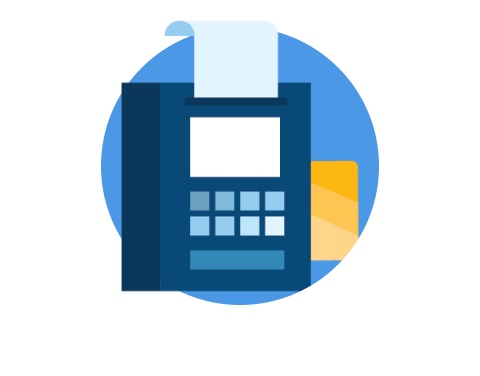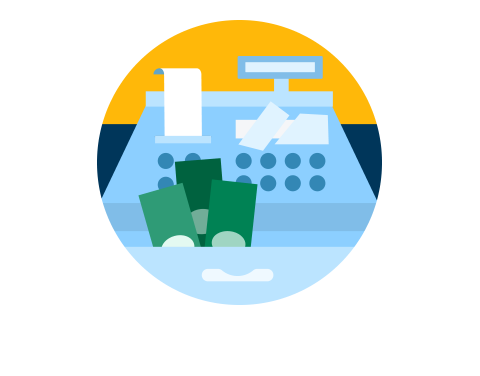How to Accept Credit Cards Without a Bank Account
Accepting credit card payments at your small business can make it faster and easier for customers to pay you. Doing so isn't free, though. At a minimum, you'll have to pay for payment processing. And getting the right point-of-sale software and hardware could add to the expenses.
What do you need to accept in-person card payments?
To accept card payments in-person, you need the following:
-
Payment processor. The service that actually initiates and completes the transaction with the card networks (such as Visa or Mastercard) and the banks is called a payment processor. Payment processors charge a transaction fee for every payment accepted.
-
Point-of-sale system. This is the software used to ring up sales, track inventory and view your sales history. Hardware can include items like a terminal, card reader, bar code scanner and cash drawer. Free POS software exists, but POS systems with more features charge monthly or annual subscription fees.
-
Card reader. A card reader might come included with the POS system; if it isn't, you may have to shop for one that's compatible with your setup. Some providers offer free card readers. More elaborate setups can cost over $1,000.
Often, the hardware and services needed to accept credit cards come bundled together from a single provider. For example, Toast's POS system works only with Toast's payment processing. In other cases, you can assemble a system with components from different providers. For example, Vend POS is compatible with various card readers and payment processors.
Make payments make sense
Find the right payment provider to meet your unique business needs.

What do you need to accept online payments?
Payment gateway: This is a digital interface that allows customers to enter their card information securely. Companies like Stripe and Braintree offer online payment gateways. Many in-person POS systems also allow merchants to accept payments online, either directly or through an integration with an e-commerce system.
Payment processor: Like it does with in-person payments, a payment processor initiates and completes online transactions with credit card companies and banks. Payment processors charge a transaction fee for every payment accepted. Many payment gateways also include payment processing services.
What happens when a customer pays with a card?
When a customer swipes, taps or dips their card into a card reader, it sets off a chain of events among intermediaries:
-
The card reader or online payment gateway securely captures the card information, and the payment processor transmits the data to the associated card network (like Visa) for approval.
-
As this is happening, the payment processor requests information from the card's network, which routes the request to the card issuer (such as Chase or Bank of America).
-
The issuer evaluates the request and either approves or denies the payment.
-
If the transaction is approved, you can accept the payment and complete the transaction.
-
Once the transaction is approved, the payment processor instructs the issuing bank to send funds.
-
The merchant gets access to those funds (less fees).
Payment service providers vs. merchant account providers
When a card transaction is completed, the funds go to a particular kind of bank account called a merchant account. In most cases, the money will be transferred to the business's account in one to two business days.
If you're working with a payment service provider — sometimes referred to as a third-party payment provider, payment facilitator or processing aggregator — the merchant account technically belongs to the payment service provider; it aggregates all of its customers' funds into one or more merchant accounts, which can then be transferred into individual accounts. Square and PayPal are examples of payment service providers.
Whether the funds from card transactions land in a dedicated merchant account or one that belongs to a payment service provider, the process of getting paid is basically the same. There are some advantages and disadvantages to each method, though.
Payment service providers pros
-
Fast to set up.
-
Most cost-effective option for businesses with low sales volumes — generally, less than $10,000 a month.
Payment service providers c ons
-
Higher risk of account disruptions. Because the merchant account ultimately belongs to the payment service provider, you're more likely to experience account holds or termination than with dedicated merchant accounts if the provider believes any transactions go against the terms of service.
-
Generally not an option for high-risk businesses, including businesses with high rates of fraud or chargebacks, or those selling items whose sales are regulated at the state or federal level, such as firearms or cannabis.
Merchant accounts pros
-
More cost-effective for businesses with higher sales volumes.
-
Generally not tied to a single brand of POS system.
-
Generally offers greater access to support representatives who know about your specific business and activity.
Merchant account cons
-
Approval process and setup can take longer compared with a payment service provider.
What else to consider before you start accepting card payments
What other services do you need?
Do you want a comprehensive solution that combines a POS system, credit card processor, report generation, staff management and more? This option offers convenience — everything works together out of the box. But there's a cost associated with those extra features. You might prefer an account that's compatible with multiple POS systems, such as a merchant account through a company like Payment Depot .
Where will you be accepting card payments?
Think through what you want a customer's checkout experience to look like. For example, a small retail shop might need one or two large countertop terminals like those offered by Clover . A cafe might want a handheld card reader so customers can pay at their table. In that case, a durable handheld POS device such as those from Toast might work best.
Businesses that do some or all of their sales online will need a way to accept card payments digitally. Some companies, such as Shopify, have tools that help customers build their online presence, including a payment page. Others companies, like Stripe or PayPal, focus more specifically on creating digital payment tools that users can add to any website.
What will it cost you?
The prices for accepting card payments vary depending on the services needed and the provider you choose, but the types of costs you'll see are relatively constant.
Hardware cost
The physical machine used to read a card's data is a must-have for in-person businesses. Card reader prices range from free for a basic reader to thousands of dollars for a comprehensive POS system. When comparing options, be sure to ask:
-
Will you own or lease the hardware?
-
Is the cost of the hardware part of the subscription cost, or is it separate?
Subscription fee
You'll usually pay a set monthly fee; the fee amount depends on the number and types of services used. Many payment service providers offer multiple pricing tiers — each with a set list of services. Some companies let you pay a fee to add a higher-tier service (like loyalty program management) to a lower-tier subscription.
Transaction fee
Every time someone pays with a card, you'll pay a fee. This fee is often a percentage of the sale price plus a fixed amount, like 2.9% plus 15 cents. You'll pay more for online transaction than for in-person transactions because the risk of fraudulent activity is higher online. Depending on the plan, the cost may be affected by other factors, such as the type of card used.
Other details to consider
-
Some companies require a contract, and canceling before the contract is up can be costly. Other companies offer month-by-month subscriptions that you can end at any time.
-
More complex payment products, especially POS systems that allow highly customized menus, might require installation, setup or training, all of which can cost extra.
-
Customer service varies. If there's a problem, will you want to speak to a person immediately?
-
Some companies share pricing details openly while others offer custom quotes to each prospective client.
Make payments make sense
Find the right payment provider to meet your unique business needs.

Top payment processors to choose from
Square
Square is a well-known payment service provider and NerdWallet's pick for top POS system. You can sign up for a free account online and start taking payments almost instantly. Fees for in-person payments start at 2.6% plus 10 cents. The company doesn't require a long-term contract or charge setup fees, batch fees, refund fees or chargeback fees. For more POS features, you can upgrade to a paid plan.
Stripe
Stripe's focus is on online payments. Its payment platform allows you to accept credit card payments (as well as other payment types) without a merchant account. You can accept payments in-person with a terminal and online with a website-embedded checkout or recurring invoices. For all online payments, Stripe charges 2.9% plus 30 cents per transaction. Like Square, it doesn't charge monthly fees, setup fees or refund fees; it does, however, have a $15 chargeback fee per lost dispute.
Payment Depot
If you do business in person, a basic payment processor like Payment Depot could be a good fit. You can buy a card reader and connect it to a variety of POS systems. There are four tiers of subscription levels; the highest monthly fee comes with the lowest transaction rates. The lowest cost tier is $79 per month with interchange plus 15 cents per transaction.
Randa Kriss, a NerdWallet small-business writer, contributed to this article.
A version of this article was first published on Fundera, a subsidiary of NerdWallet.
Accept payments without worry
See our payment provider recommendations that fit your business.

How to Accept Credit Cards Without a Bank Account
Source: https://www.nerdwallet.com/article/small-business/how-to-accept-credit-card-payments
0 Response to "How to Accept Credit Cards Without a Bank Account"
Post a Comment